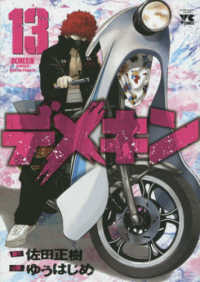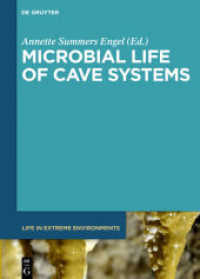- ホーム
- > 洋書
- > 英文書
- > Cinema / Film
Full Description
Horror films have exploded in popularity since the tragic events of September 11, 2001, many of them breaking box-office records and generating broad public discourse. These films have attracted A-list talent and earned award nods, while at the same time becoming darker, more disturbing, and increasingly apocalyptic. Why has horror suddenly become more popular, and what does this say about us? What do specific horror films and trends convey about American society in the wake of events so horrific that many pundits initially predicted the death of the genre? How could American audiences, after tasting real horror, want to consume images of violence on screen?
Horror after 9/11 represents the first major exploration of the horror genre through the lens of 9/11 and the subsequent transformation of American and global society. Films discussed include the Twilight saga; the Saw series; Hostel; Cloverfield; 28 Days Later; remakes of The Texas Chainsaw Massacre, Dawn of the Dead, and The Hills Have Eyes; and many more. The contributors analyze recent trends in the horror genre, including the rise of 'torture porn,' the big-budget remakes of classic horror films, the reinvention of traditional monsters such as vampires and zombies, and a new awareness of visual technologies as sites of horror in themselves. The essays examine the allegorical role that the horror film has held in the last ten years, and the ways that it has been translating and reinterpreting the discourses and images of terror into its own cinematic language.
Contents
Acknowledgments
Introduction (Aviva Briefel and Sam J. Miller)
Part One. Why Horror?
Chapter 1. Black Screens, Lost Bodies: The Cinematic Apparatus of 9/11 Horror (Laura Frost)
Chapter 2. Let's Roll: Hollywood Takes on 9/11 (Elisabeth Ford)
Chapter 3. Transforming Horror: David Cronenberg's Cinematic Gestures after 9/11 (Adam Lowenstein)
Part Two. Horror Looks at Itself
Chapter 4. Caught on Tape? The Politics of Video in the New Torture Film (Catherine Zimmer)
Chapter 5. Cutting into Concepts of "Reflectionist" Cinema? The Saw Franchise and Puzzles of Post-9/11 Horror (Matt Hills)
Chapter 6. The Host versus Cloverfield (Homay King)
Chapter 7. "Shop 'Til You Drop!": Consumerism and Horror (Aviva Briefel)
Part Three. Horror in Action
Chapter 8. Historicizing the Bush Years: Politics, Horror Film, and Francis Lawrence's I Am Legend (Steffen Hantke)
Chapter 9. "I Am the Devil and I'm Here to Do the Devil's Work": Rob Zombie, George W. Bush, and the Limits of American Freedom (Linnie Blake)
Chapter 10. "Forever Family" Values: Twilight and the Modern Mormon Vampire (Travis Sutton and Harry M. Benshoff)
Chapter 11. Assimilation and the Queer Monster (Sam J. Miller)
Selected Bibliography
Selected Filmography
Contributors
Index








